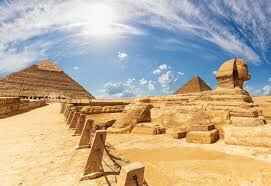The Great Sphinx of Giza is one of the world’s most iconic and enigmatic monuments. Standing proudly on the Giza Plateau, it has intrigued historians, archaeologists, and travelers for centuries. Its grandeur and mystery have made it a must-visit for anyone interested in ancient Egyptian civilization, and it is one of the most photographed landmarks in the world. But there is so much more to the Great Sphinx than meets the eye. This ancient statue, with the body of a lion and the head of a Pharaoh, holds many secrets that continue to fascinate people across the globe.
The Origins of the Great Sphinx
The Sphinx is believed to have been built during the reign of Pharaoh Khafre, around 2500 BC, although some theories suggest it may be even older. It is carved from a single piece of limestone and stands 66 feet tall, 240 feet long, and 63 feet wide. This massive size makes the Great Sphinx one of the largest monolithic statues in the world, and its scale alone is enough to leave visitors in awe.
The statue is thought to represent Pharaoh Khafre, who is depicted with the head of a lion to symbolize strength and power. The body of the lion is often associated with the regal qualities of the Pharaoh, signifying both his divine right to rule and his formidable prowess. However, there is much debate about the exact purpose of the Sphinx and why it was built.
Theories and Mysteries
One of the most enduring mysteries of the Sphinx is the question of its purpose. Some scholars believe it was built as a guardian figure for the pyramids, watching over the tombs of the pharaohs and symbolizing divine protection. Others argue that it could be an astronomical marker, aligned with the rising sun during certain solstices, suggesting the Sphinx may have had a religious or ritualistic function.
The face of the Sphinx, which is often considered a likeness of Pharaoh Khafre, is also a subject of intrigue. Over the centuries, the face has suffered significant erosion, which has led some researchers to speculate that it might not even resemble Khafre at all. There have been various theories suggesting the Sphinx may have originally represented a different ruler, with the face being altered to match Khafre later on.
Perhaps one of the most compelling mysteries surrounding the Sphinx is its age. While mainstream scholars have long dated the monument to the reign of Khafre, alternative theories suggest the Sphinx could be far older, potentially dating back to 10,000 BC or earlier. This theory, known as the “Water Erosion Hypothesis,” is based on the idea that the erosion patterns found on the Sphinx’s surface were caused by rainwater, which would indicate the monument predates the desertification of Egypt. Although controversial, this hypothesis has sparked heated debates among archaeologists and Egyptologists.
Restoration Efforts and Preservation
The Great Sphinx has also been the focus of numerous restoration efforts over the years. As one of the world’s most famous monuments, it is constantly under threat from the elements, particularly wind and sand, which erode the stone and can cause significant damage. Several restoration campaigns were launched in the 19th and 20th centuries to preserve the monument and halt its deterioration. These included attempts to repair the Sphinx’s nose, which was famously damaged, likely by iconoclasts during the Middle Ages.
The most notable restoration project began in the 1980s, when Egypt’s Supreme Council of Antiquities, in partnership with international organizations, initiated a large-scale conservation effort. These efforts included the installation of protective barriers around the Sphinx, repairs to the erosion damage, and the removal of layers of sand and debris that had accumulated over time. Despite these efforts, the Sphinx remains vulnerable, and ongoing restoration work continues to this day.
What to Expect During Your Visit
Visiting the Great Sphinx of Giza is an unforgettable experience. As you approach the monument, you’ll be struck by its enormous size and its sheer presence. The Sphinx is situated near the Pyramids of Giza, which adds to the mystique of the entire area. Visitors can explore the site from various angles, taking in the panoramic view of the pyramids and the surrounding desert landscape.
One of the best ways to truly appreciate the Great Sphinx is by taking a guided tour. While the site is accessible to visitors on their own, having an expert guide can provide you with a deeper understanding of the history and mysteries surrounding the Sphinx. Your guide will explain the significance of the monument, share fascinating details about its construction, and reveal some of the ongoing research and theories about its origins.
For those who want to get up close and personal with the Sphinx, you can even take part in a great Sphinx of Giza tour that includes a detailed visit to the monument and surrounding areas. These tours often include trips to the nearby Valley Temple, where it is believed the Pharaoh’s body was prepared for burial, as well as the Giza Plateau’s other iconic pyramids.
Modern-Day Discoveries
In recent years, there have been several exciting discoveries made around the Great Sphinx. Archaeologists have uncovered new chambers and tunnels beneath the monument, sparking even more questions about its true purpose and the civilization that built it. These findings, although still being investigated, suggest that there may be more hidden beneath the surface of the Sphinx than previously thought.
The discovery of ancient artifacts and inscriptions near the Sphinx has also provided valuable insights into the religious and political context of the time. These findings help us better understand the Sphinx’s role in ancient Egyptian society and its connection to the pharaohs and the gods they worshipped.
How to Enhance Your Visit
If you’re planning a visit to the Great Sphinx, there are plenty of ways to enhance your experience. One great option is to visit the Sphinx during the early morning or late afternoon when the light is softer and the temperatures are more comfortable. This will also give you the opportunity to capture some stunning photos of the monument in the best lighting.
Additionally, consider taking a great Sphinx of Giza tour that includes both the Sphinx and the surrounding pyramids. A well-rounded tour can provide a deeper understanding of how the Sphinx fits into the larger landscape of ancient Egyptian history and culture.
Conclusion
The Great Sphinx of Giza remains one of ancient Egypt’s most awe-inspiring and mysterious monuments. Its origins, purpose, and the secrets it holds continue to intrigue visitors and researchers alike. Whether you’re a history enthusiast, an archaeology lover, or simply a traveler looking for an unforgettable experience, a visit to the Sphinx is sure to leave you in awe of its magnificence and the mysteries it still holds. Don’t miss the chance to explore this iconic monument and uncover the many stories hidden beneath its surface.





Be First to Comment